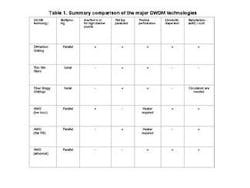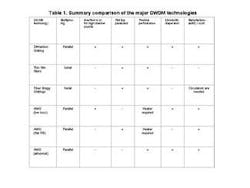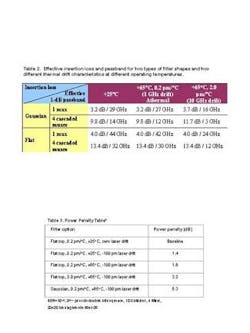Trends in DWDM multiplexers and their impact on network performance
Vendors work to improve three key multiplexer characteristics in response to the cost and reliability demands of today's DWDM networks.
YURI A. YUDIN, Confluent Photonics, and DR. CRAIG A. ARMIENTO--Network planners emphasize cost and reliability as requirements for practical deployment of DWDM systems. Cost factors include initial capital expenses and operating expenses over the lifetime of the network. Service providers are also faced with increasing pressure to guarantee network reliability via service-level agreements (SLAs) that impose penalties triggered by quality of service violations. DWDM networks that minimize the number of deployed elements will yield both cost and reliability improvements.
Optical multiplexers (muxes) and demultiplexers (demuxes) are the cornerstones of DWDM networks deployed by the telecommunications and cable television industries. In addition to their use at terminal points, mux/demux components are also used as fundamental building blocks of advanced network elements such as optical add/drop multiplexers (OADMs) and optical-crossconnect switches. The pervasive use of these components requires constant improvement to satisfy network cost and reliability imperatives.
Mux development trends address network-level concerns
Telecom and cable TV network operators continue to increase the number of wavelengths used in their networks, which has led to the need for high-channel-count muxes (≥16 channels). Several mux development trends have emerged in response to cost and network reliability pressures. Vendors have responded by improving three key mux characteristics: insertion loss, filter profiles, and thermal characteristics (which also translates into a reduced dependence on internal heaters).
Mux insertion loss directly impacts the power budget of a DWDM link. The use of muxes and demuxes with low loss extends fiber reach and can eliminate the reliance on optical amplifiers. An unamplified link is most likely for metro and access networks, which are characterized by short internode spans (typically < 80 km). A reduced number of amplifiers results in lower costs and avoids the operational and design complexities that result from their use (e.g., noise, power balancing, gain tilt).
The mux filter shape is also an important consideration in overall network design. The earliest mux devices had Gaussian profiles, which occur naturally from their design. A Gaussian profile can be problematic in a system, because drift of the transmitter wavelength from the peak of the filter profile increases insertion loss and degrades system margin.
Network designers have addressed this issue by adding expensive wavelength lockers to transmitters. However, wavelength lockers do not solve this problem if the mux filter characteristics change with operating temperature. Vendors have introduced mux devices with flat filter profiles that relax the need to control the transmitter wavelength to a precise value. Flat filter muxes, however, often require additional elements in the optical path that increase insertion loss. For instance, arrayed-waveguide-grating (AWG)-based muxes generally add 2-3 dB of insertion loss to flatten the filter profile. In contrast, recently designed free-space diffraction-grating (FSDG) muxes sacrifice only 0.5 dB of insertion loss to achieve a flat filter response.
Another important mux characteristic is its thermal behavior. Some mux technologies such as AWGs are very temperature-sensitive. AWG vendors have addressed this problem by using heaters that keep the waveguide chip at a controlled temperature (~75°C). But a heater introduces several cost and reliability issues. A system designer must incorporate control circuitry to use a heater-controlled mux. From a reliability standpoint, a heater failure has a significant network impact since all wavelengths will be affected. Growing demands on network reliability, fueled by widespread use of SLAs, has prompted interest in passive components that do not require power- or temperature-control elements. AWG mux vendors have been working toward modified designs that eliminate dependence on heaters.
Mux technologies
Table 1 shows a qualitative comparison of the major DWDM mux technologies. Thin-film filters (TFFs) and fiber Bragg gratings (FBGs) were first used in low-count DWDM systems. Although they utilize different physical mechanisms, they both function by filtering wavelengths serially, where individual elements are used to multiplex (or demultiplex) wavelengths on a one-by-one basis.¹ TFFs use concatenated interference filters, each of which is fabricated with a different set of dielectric coatings designed to pass a single wavelength. They work well for low channel counts but have limitations at higher channel counts due to size and accumulated insertion losses. FBGs rely on a grating formed in the fiber core, which reflects a single wavelength and transmits other wavelengths.² Each FBG is designed with a different grating period to multiplex or demultiplex a single wavelength in the system. The reflected wavelength is demultiplexed from the system fiber using a circulator. As was the case for the TFF, the serial process restricts the practical channel count due to size, accumulated insertion losses, and costs of the individual piece parts.
In contrast to TTFs and FBGs, AWGs and FSDG devices use a parallel multiplexing approach that is more conducive to high-channel-count applications. AWGs use silica waveguide structures to diffract light into individual output waveguides.³ AWGs are made in several versions (low-loss, flat-top, athermal) and do not commonly offer all three features in a single device. FSDG muxes use a ruled or etched diffraction grating as the dispersion engine and classical optics to separate wavelengths into individual output fibers.4
System implications
Many mux parameters influence network performance, including insertion loss, filter shape, and thermal characteristics. The impact of insertion loss is simple to understand. In a simple point-to-point DWDM link, the insertion loss of the mux and demux can be a significant portion of the total link loss. For instance, athermal flat-top FSDG muxes have insertion losses of 4 dB compared to flat-top AWGs, which can have insertion losses in excess of 7.5 dB. Use of an FSDG mux/demux pair would result in 7-dB less attenuation compared to the AWG mux/demux. In networks where the link design is power-limited, the use of diffraction-grating technology would allow an increased link length of 35 km. This calculation is based on a typical fiber attenuation of 0.2 dB/km. Low-insertion-loss mux and demux components will significantly improve the opportunities for amplifier-free designs in metro and access networks.
Quantifying the impact of filter shape and thermal behavior is more difficult and requires the use of network simulation tools. A three-node DWDM optical network was simulated using a commercial software tool. The simulated network used a mux at the transmitter node, a demux at the receiver node and an OADM (using another mux and demux) at the intermediate node. The nodes were connected by 20 km of singlemode fiber and did not use optical amplifiers. This simple configuration represents a portion of a metro network that uses OADMs to transport wavelengths. This network was chosen to demonstrate filter concatenation effects, which is the effective narrowing of the channel passband as signals pass through multiple mux/demux pairs. In the simulated network, the transmitted source passes through four mux/demux filters before it is received. Forty 10-Gbit/sec signals were simulated in the network.
Table 2 shows the impact of mux thermal properties and cascaded filter profiles on the effective insertion loss and passband. Four different filters are represented. Two have Gaussian profiles and two have flat profiles. Each filter type is represented by two cases with different thermal properties: One has a thermal dependence of only 0.2 pm/°C, and the other has a thermal dependence of 2 pm/°C. The former thermal characteristic is representative of FSDG muxes and considered a truly athermal mux. A value of 2 pm/°C is not athermal. The flat-profile filter was modeled with a higher insertion loss than the Gaussian-profile filter, as is generally the case in mux products.
The impact of changing the operating temperature of a single mux is shown in Table 2. The Gaussian profile, which has a modeled filter width of 29 GHz at room temperature, is reduced to 27 and 16 GHz, for the case of thermal drifts of 0.2 and 2 pm/°C, respectively. A similar narrowing of the effective passband occurs for the flat-top filter. These data demonstrate the importance of specifying mux components with a very low sensitivity to operating temperature. While many vendors offer athermal products, it is important to quantify the degree of thermal performance or the effective passband over the operating-temperature range. The effective passband is defined as the spectral width centered on the ITU grid that is clear over the entire range of operating temperatures.
Filter concatenation effects also narrow the effective system passband, as shown by comparing the case of a single mux with the case of four cascaded muxes. The effective passband for the Gaussian-profile filter is reduced from 29 GHz to 14 GHz as a result of cascading four mux/demux filters at room temperature. When operated at 65°C, a three-node system based on Gaussian-profile muxes and demuxes with a thermal drift of 2 pm/°C has an effective passband of only 5 GHz. As shown in Table 2, flat-profile filter muxes have much wider effective passbands than Gaussians in cascaded situations. This effect is an important reason for the trend toward flat-top mux designs.
The transmission characteristics for the three-node network were simulated for the mux options listed in Table 2. The simulation, which was conducted for 10-Gbit/sec data rates (SONET OC-192), allowed the transmitter wavelength to drift 100 pm to test the robustness of the network for each mux type. In all cases, the bit-error ratio (BER) was calculated as a function of the received power. The baseline curve shows the BER of the system at room temperature using an athermal flat-top filter without wavelength drift (transmitter on the ITU grid). As the transmitter wavelength drifts, there is BER degradation for all mux cases. The athermal (0.2 pm/°C) flat-top mux yields the best performance under conditions of wavelength drift. The performance at 25°C and 65°C are nearly identical because of the athermal properties of the device. A flat-top mux with a thermal sensitivity of 2 pm/°C is significantly worse when operated at 65°C. The worst performer is the 2 pm/°C Gaussian-profile mux. Table 3 shows the power penalty associated with each mux type assuming that the designer must keep BER at a 10-10 level.
The data demonstrates that system performance margins can be made less sensitive to transmitter drift by using muxes with flat-top profiles and athermal properties. As a practical matter, a passive athermal mux is preferred, since it eliminates active heaters in the network. A passive mux eliminates the need to provide power and electronic control of a heater. This arrangement reduces cost and system complexity and improves network reliability by eliminating the potential for mux outages due to heater failures.
Satisfying the three essentials
Optical muxes and demuxes play a significant role in the performance and robustness of DWDM systems. Their pervasive use throughout the network requires system designers to understand their operation and specification.
The need to control the cost and enhance reliability in DWDM networks has motivated vendors to improve critical mux parameters such as insertion loss, filter shape, and thermal behavior. In high-channel-count networks, FSDG mux and demux components can satisfy all three essential parameters simultaneously, relieving network designers of having to trade off various performance requirements.
SIDEBAR
Multiplexer performance parameters: A few definitions
There are several multiplexer (mux) parameters that have significant impact on system performance: insertion loss, passband, filter profile, and thermal properties. (For further discussion on these parameters, see "Mux/DeMux Optical Specifications and Measurements" at www.confluentphotonics.com.)
Insertion loss is perhaps the most important and frequently specified mux parameter, because it impacts the reach of an optical signal. Although some vendors define insertion loss at the peak transmission within the passband, it is more meaningful to specify insertion loss at the minimum transmission within the passband, which typically occurs at the passband edges. This definition is more relevant to system designers, since it corresponds to the worst-case scenario. It is also important to ensure that the insertion-loss values include connector losses.
Filter width refers to the spectral width of the optical-channel transmittance usually at points where the insertion loss has increased by 0.5, 1, or 3 dB. The filter width is specified in picometers (pm) or GHz and is measured at 25°C. Mux spectral characteristics, however, have a thermal dependence that results in a shift of the filter profile. For the system designer, channel passband is a more relevant parameter, which accounts for the spectral variations of the filter across the full temperature range (typically -5 to +65°C).
Channel passband is defined as the clear spectral window centered on the ITU grid that can be guaranteed across the entire range of operating temperatures. Passband shape refers to the spectral response profile. The two most common shapes are Gaussian and flat-top. When concatenated, Gaussian-filter response is significantly narrowed, whereas flat-top-filter concatenation better preserves its original shape and passband.
Athermality and thermal drift refer to the variation of mux properties over the operating-temperature range. The degree of athermality is often specified by its filter spectral drift in pm/°C. Muxes can be made actively athermal (using a heating/cooling element to maintain a constant temperature) or passively athermal (without heater or cooler). Passive devices are preferred due to their reliability and simplicity of use.
BIOS
Yuri A. Yudin is a senior fiber-opticvsystems engineer at Confluent Photonics Corp. (Salem, NH). He can be reached via the company's Website, www.confluentphotonics.com. Dr. Craig A. Armiento, a photonics industry consultant, can be reached at [email protected].


